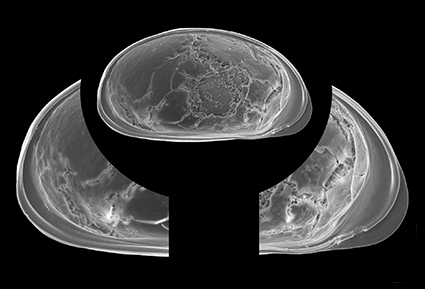Abstract
Elpidium is the most common ostracod genus occurring in phytotelmata in the Neotropical region, with distributions ranging from Florida, USA in the north to Rio Grande do Sul, Brazil in the south. However, the genus remains poorly known both in terms of diversity and of the distributional pattern of its species. Here, we describe six new species of Elpidium, E. oxumae n. sp., E. cordiforme n. sp., E. picinguabaense n. sp., E. eriocaularum n. sp., E. higutiae n. sp., E. purium n. sp., all from phytotelm environments in the Brazilian Atlantic rain forest. In addition, we discuss the distributional pattern and endemicity levels of Elpidium species in the light of these new taxonomic results and argue about possible misunderstandings on the distribution of the type species E. bromeliarum.
References
Benzing, D.H. (2000) Bromeliaceae: profile of an adaptive radiation. Cambridge University Press, Cambridge, 675 pp.https://doi.org/10.1017/CBO9780511565175
Bornschein, M.R., Firkowski, C.R., Baldo, D., Ribeiro, L.F., Belmonte-Lopes, R., Corrêa, L., Morato, S.A.A. & Pie, M.R. (2015) Three new species of phytotelm-breeding Melanophryniscus from the Atlantic Rainforest of southern Brazil (Anura: Bufonidae). PLoS ONE, 10 (12), 1–35.https://doi.org/10.1371/journal.pone.0142791
Colin, J.P. & Danielopol, D.L. (1981) Sur la morphologie, la systématique, la biogéographie et l’évolution des ostracodes Timiriaseviinae (Limnocytheridae). Paléobiologie Continentale, 11, 1– 51.
Danielopol, D.L. (1975) Remarques sur la diversification morphologique de trois espèces d’Elpidium (Ostracoda) à Cuba. Bulletin of American Paleontology, 65 (282), 47–60.
Danielopol, D.L., Pinto, R.L., Gross, M., Pereira, J.S. & Riedl, N. (2014) On the evolutionary biology of Elpidium ostracods (Limnocytheridae, Timiriaseviinae): a proposal for pluridisciplinary studies. Geo-Eco-Marina, 20, 87–129.
Fish, D. (1976) Structure and composition of the aquatic invertebrate community inhabiting epiphytic bromeliads in south Florida and the discovery of an insectivorous bromeliad. PhD thesis, University of Florida, Gainesville, Florida, 77 pp.
Horne, D.J., Cohen, A. & Martens, K. (2002) Taxonomy, morphology and biology of quaternary and living Ostracoda. In: Holmes, J.A. & Chivas, A.R. (Eds.), The Ostracoda. Applications in Quaternary Research. American Geophysical Union, Washington, D.C., pp. 5–36.https://doi.org/10.1029/131GM02
Jocqué, M., Fiers, F., Romero, M. & Martens, K. (2013) Crustacea in phytotelmata: a global overview. Journal of Crustacean Biology, 33 (4), 451–460.https://doi.org/10.1163/1937240X-00002161
Larridon, I., Tanaka, N., Liang, Y., Phillips, S.M., Barfod, A.S., Cho, S.H., Gale, S.W., Jobson, R.W., Kim, Y.D., Li, J., Muasya, A.M., Parnell, J.A.N., Prajaksood, A., Shutoh, K., Souladeth, P., Tagane, S., Tanaka, N., Yano, O., Mesterházy, A., Newman, M.F., Ito, Y. (2019) First molecular phylogenetic insights into the evolution of Eriocaulon (Eriocaulaceae, Poales). Journal of Plant Research, 132, 589–600. https://doi.org/10.1007/s10265-019-01129-3
Little, T.J. & Hebert, P.D.N. (1996) Endemism and ecological islands: the ostracods from Jamaican bromeliads. Freshwater Biology, 36 (2), 327–338. https://doi.org/10.1046/j.1365-2427.1996.00094.x
Meisch, C., Smith, R.J. & Martens, K. (2019) A subjective global checklist of the extant non-marine Ostracoda (Crustacea). European Journal of Taxonomy, 492, 1–135. https://doi.org/10.5852/ejt.2019.492
Müller, F. (1880) Wasserthiere in Baumwipfeln: Elpidium bromeliarum. Kosmos, 4 (1878–1879), 386–388.
Müller, F. (1881) Descrição do Elpidium bromeliarum, crustáceo da família dos cytherideos. Archivos do Museu Nacional do Rio de Janeiro, IV, 27–35.
Nadaline, J., Ribeiro, L.F., Teixeira, L., Vannuchi, F.S. & Bornschein, M.R. (2019) New record of Melanophryniscus biancae Bornschein, Baldo, Pie, Firkowski, Ribeiro & Corrêa, 2015 (Anura, Bufonidae) from Paraná, Brazil, with comments on its phytotelm-breeding ecology. Check List, 15 (5), 821–826. https://doi.org/10.15560/15.5.821
Pereira, J.S., Rocha, C.E.F. & Pinto, R.L. (2019) On three new species of Elpidium Müller, 1880 and the re-description of Elpidium laesslei (Tressler, 1956) from Jamaica (Ostracoda: Podocopida: Limnocytheridae). Zootaxa, 4604 (1), 103–140. https://doi.org/10.11646/zootaxa.4604.1.4
Pereira, J.S., Rocha, C.E.F., Pinto, R.L. & DaSilva, M.B. (2022) A new species of Elpidium (Crustacea: Ostracoda: Limnocytheridae) from Brazil and a morphological phylogenetic proposal for the genus. Zoological Studies, 61 (27), 1–17 https://doi.org/10.6620/ZS.2022.61-27
Pereira, J.S., Schneider, D.I.D., Rocha, C.E.F. & Pinto, R.L. (2017) Carapace ontogeny of the bromeliad dwelling ostracod Elpidium bromeliarum Müller, 1880 (Crustacea: Ostracoda). Journal of Natural History, 51 (35–36), 2185–2196.https://doi.org/10.1080/00222933.2017.1360529
Picado, C. (1913) Les broméliacées épiphytes considérées comme milieu biologique. Bulletin des Sciences de la France et de la Belgique, 47 (1913), 215–360.
Pinto, I.D. & Purper, I. (1970) A Neotype for Elpidium bromeliarum Müller, 1880 (type species for the genus) and a revision of the genus Elpidium (Ostracoda). Escola de Geologia de Porto Alegre, 19, 1–23.
Pinto, I.D. & Sanguinetti, Y.T. (1962) A complete revision of the genera Bisulcocypris and Theriosynoecum (Ostracoda) with the world geographical and stratigraphical distribution (including Metacypris, Elpidium, Gomphocythere and Cytheridella). Publicação Especial da Escola de Geologia de Porto Alegre, 4, 1–165, pls. 1–17.
Pinto, R.L. & Jocqué, M. (2013) A new species of Elpidium (Crustacea, Ostracoda) from bromeliads in Cusuco National Park, Honduras. ZooKeys, 313, 45–59.https://doi.org/10.3897/zookeys.313.4904
Pinto, R.L., Rocha, C.E.F. & Martens, K. (2008) On the first terrestrial ostracod of the superfamily Cytheroidea (Crustacea, Ostracoda): Description of Intrepidocythere ibipora n. gen. n. sp. from forest leaf litter in São Paulo State, Brazil. Zootaxa, 1828 (1), 29–42. https://doi.org/10.11646/zootaxa.1828.1.3
Tressler, W.L. (1941) Ostracoda from Puerto Rican bromeliads. Journal of the Washington academy of sciences, 31 (6), 263–269.
Tressler, W.L. (1956) Ostracoda from bromeliads in Jamaica and Florida. Journal of the Washington academy of sciences, 46 (10), 333–336.

